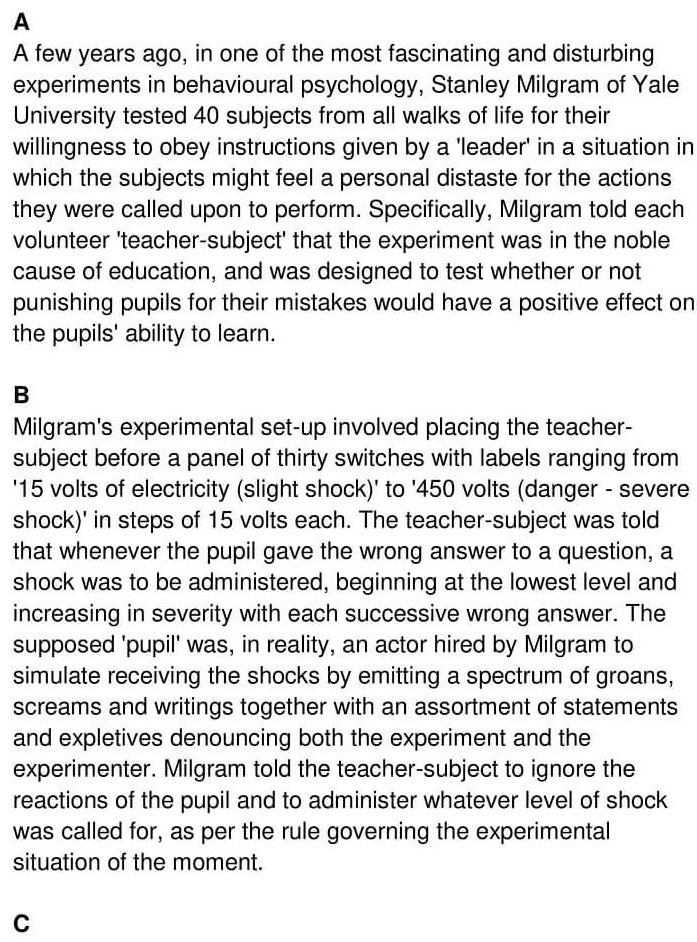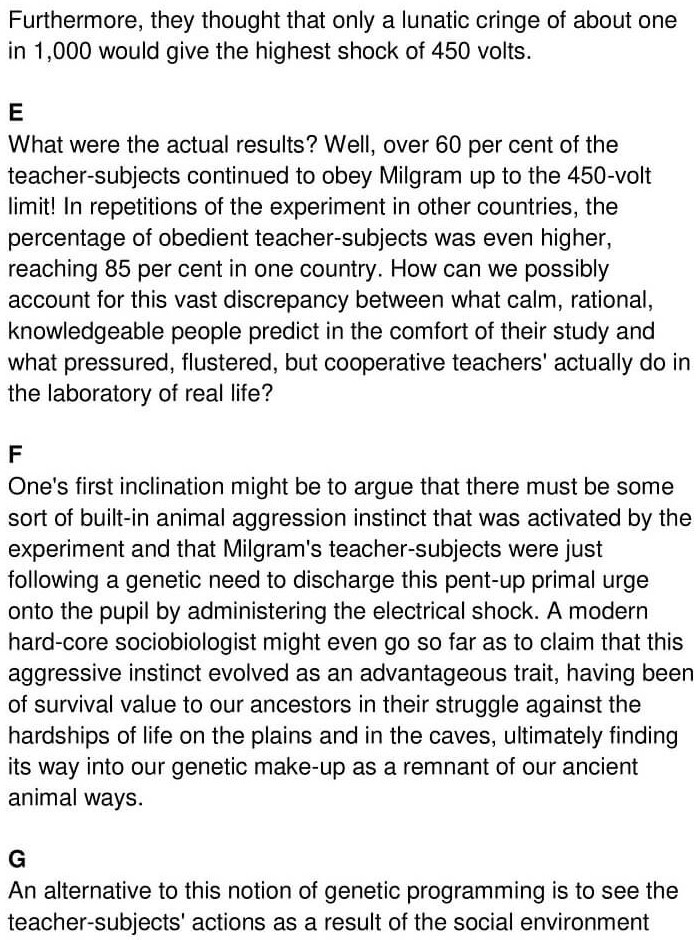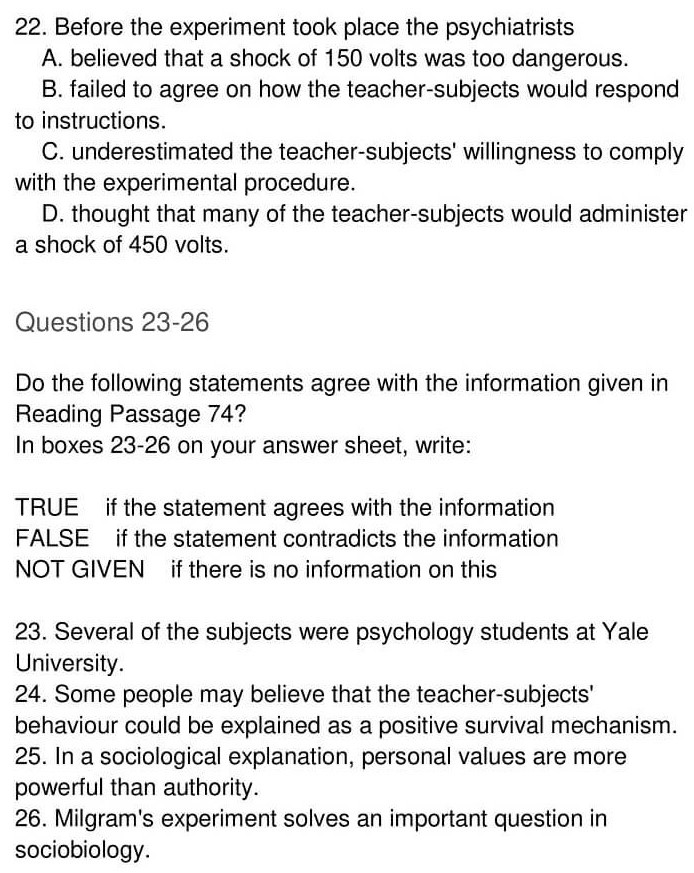Nature or Nurture – IELTS Reading Answers
7 min read
Updated On
-
Copy link
Table of Contents

Limited-Time Offer : Access a FREE 10-Day IELTS Study Plan!
The IELTS Academic Reading: Cambridge Reading Sample; ‘Nature or Nurture’ with answers. The post will discuss the answers to questions 14-26. The headline of the passage is ‘Nature or Nurture’
Nature or Nurture






Answers
Unlock Answers
| Question Number | Answer | Explanation |
|---|---|---|
| 14 | F | In paragraph F, it is mentioned in the second-third sentence that an experiment activated some built-in animal aggression instinct and that Milgram’s teacher-subjects were following a genetic need to discharge this pent-up primal urge onto the pupil by administering the electrical shock. Here, the paragraph describes the experiment to administer shock, which explained human aggression. Milgram’s teacher-subjects were following a genetic need, which can be referred to as teacher-subjects behaviour. Therefore, the question (A biological explanation of the teacher-subjects behaviour) matches with the paragraph, and so, the answer is F |
| 15 | A | In paragraph A, it is described in the sixth sentence that Milgram told each volunteer ‘teacher subjects that the experiment was in the noble cause of education and it was designed to test if punishing pupils may positively affect the pupil’s ability to learn. We understand that Milgram explained the experiment to the teacher-subjects. Thus, the statement (The explanation Milgram gave the teacher-subjects for the experiment) agrees with the information, so the answer is A. |
| 16 | B | In the eighth sentence of paragraph B, we can observe that the supposed pupil was, in reality, an actor hired by Milgram for the experimental setup. Thus, it is mentioned that the pupils who were involved in the experiments were identified as actors. This is their identity. So, the statement (The identity of pupils) agrees with the paragraph, and the answer is B. |
| 17 | D | Paragraph D states the psychiatrists’ prediction of the average percentage of people willing to administer the highest shock levels of 450 bolts. The overwhelming consensus was that virtually all the teacher-subjects would refuse to obey and administer 450V shocks. We understand from the paragraph that the psychiatrists gave some expected figures on how many people would go beyond the average shocks. Here, the word “consensus” means general agreement. So, the question (The expected statistical outcome) matches the information. As a result, the answer is D. |
| 18 | I | Paragraph I narrates the two radically different explanations for why several teacher-subjects were willing to forgo their sense of personal responsibility for the sake of institutional authority. Also, the problem of modern sociobiology is described wherein the other way, and it is mentioned that sociobiology is concerned with elucidating the biological basis of all behaviour. Here, concerned with refers to general aim, elucidating means to explain, and the entire paragraph describes the sociobiology study and problems of biologists. Thus, the statement (the general aim of sociobiology study) agrees with the information, and the answer for it is I. |
| 19 | C | From the eighth sentence in paragraph C, we understand that most of the teacher-subjects balked at administering the higher levels of punishment to the pupils and turned to Milgram with complaints that Milgram calmly convinced the teacher-subjects to ignore the pupil’s cries and concentrate on continuing the experiment. Here, balked means hesitate, and convince means to persuade. Thus, the statement (The way Milgram persuaded the teacher-subjects to continue) agrees with the paragraph’s information, so the answer is C. |
| 20 | B | The answer for the question can be found in the eighth line in Paragraph A, where Milgram explains the experiment to the volunteer, ‘teacher subject. Further, Milgram describes that the experiment was designed to test whether or not punishing the pupils for their mistakes would positively affect their ability to learn. In conclusion, we understand why Milgram wanted the teacher-subjects to punish the pupils. Here, positive effect refers to help and ability to learn means learning. So, the correct answer is B. Punishment helps learning. |
| 21 | D | We can find the answer in paragraph B which narrates the explanation given by Milgram to the teacher-subjects. We can observe from the last four lines that Milgram suggested the teacher-subjects ignore the pupil’s reaction and to continue to administer whatever level of shock was called for, according to the rule governing the experimental situation. Here, to administer whatever level of shock refers to punishment. So, it’s clear the answer is D. Give punishment according to a rule. |
| 22 | C | The answer to this question can be traced in two paragraphs, D and E. In paragraph D, we notice that Milgram has explained his idea to a group of 39 psychiatrists before experimenting and asked them to predict the average percentage of people who would be ready to administer the highest shock level to the pupils, all the psychiatrists predicted that virtually all the teacher-subjects would refuse to obey the experimenter. Here, the experimenter is Milgram.
Meanwhile, Paragraph E describes the actual results, stating that around 60% of the teacher-subjects continued to obey Milgram up to the 450-volt limit. Here, we can understand that a large number of teacher-subjects continued to obey Milgram. In conclusion, the answer is C. Underestimate the teacher-subjects willingness to comply with the experimental procedure. Here, comply means to obey. |
| 23 | NOT GIVEN | In paragraph A, it is mentioned that Stanley Milgram, the experimenter from Yale University, was given a task to test 40 subjects from all walks of life for their willingness to obey instructions given by a leader in several situations. Also, Milgram specifically tells each volunteer, ‘teacher-subjects’ , that the experiment was for the noble cause of education. Somehow, the identity of the teacher-subjects is not mentioned anywhere in the paragraph. So, the answer is NOT GIVEN. |
| 24 | TRUE | The answer to this question can be located in the fifth line of paragraph F, where it is mentioned that a modern hard-core sociobiologist might even go so far as to claim that this aggressive instinct evolved as an advantageous trait having been of survival value to our ancestors in their struggle against the hardships of life on the plains and in the caves. Here, aggressive instinct means teacher-subject’s behavior and an advantageous trait refers to a positive survival mechanism. So, the answer is True. |
| 25 | FALSE | In Paragraph H, the author explains that the subject merges his unique personality and personal and moral code with that of larger institutional structures surrendering individual properties. Here, merge refers to equality, and unique personality and moral code mean personal values. However, the answer isn’t relevant to the question, so the answer is False. |
| 26 | FALSE | The answer to the question can be traced in Paragraph I, where two radically different explanations are narrated for why many teacher-subjects were willing to forgo their sense of personal responsibility. In the fourth line of the paragraph, it is narrated that the problem for biologists, psychologists, and anthropologists is to sort out which of the two polar explanations is more plausible. To conclude, they are not sure about which explanation is more plausible or reasonable. So, Milgram’s experiment failed to solve the sociology question. As a result, the answer is False. |
Check More IELTS Reading Answers
| Educating Psyche Answers | The Falkirk Wheel Answers |
| The History Of Glass Answers | The Nature Of Genius Answers |
| The Rocket From East To West Answers | Trees In Trouble Answers |
Also check :
Practice IELTS Reading based on question types

Start Preparing for IELTS: Get Your 10-Day Study Plan Today!
Recent Articles

Nehasri Ravishenbagam

Haniya Yashfeen

Haniya Yashfeen

Haniya Yashfeen




Post your Comments